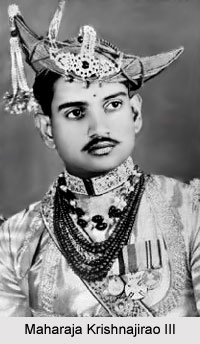 Krishnajirao III was the 3rd and final ruling Maharaja of the princely state of Dewas senior. He reigned over the region from 23rd March 1947 to 27th June 1948. He was born on 12th May 1932, to Maharaja Vikramsinhrao Tukojirao of Dewas, also known as Shahoji II, and hi wife Shrimant Akhand Soubhagyavati Maharani Pramilabai Raje Sahib Bhonsle. He had three sisters, namely Shrimant Akhand Soubhagyavati Maharajkumari Shaliniraje Sahib Maharaj Bhonsle, Maharajkumari Vijayaraje Sahib Maharaj Shitole and Maharajkumari Urmilaraje Sahib Maharaj Ghorpade. When Krishnajirao III was merely 15 years of age, his father Vikramsinhrao Tukojirao, abdicated the throne of Dewas senior and became the Shahoji II, Maharaja of the princely state of Kolhapur.
Krishnajirao III was the 3rd and final ruling Maharaja of the princely state of Dewas senior. He reigned over the region from 23rd March 1947 to 27th June 1948. He was born on 12th May 1932, to Maharaja Vikramsinhrao Tukojirao of Dewas, also known as Shahoji II, and hi wife Shrimant Akhand Soubhagyavati Maharani Pramilabai Raje Sahib Bhonsle. He had three sisters, namely Shrimant Akhand Soubhagyavati Maharajkumari Shaliniraje Sahib Maharaj Bhonsle, Maharajkumari Vijayaraje Sahib Maharaj Shitole and Maharajkumari Urmilaraje Sahib Maharaj Ghorpade. When Krishnajirao III was merely 15 years of age, his father Vikramsinhrao Tukojirao, abdicated the throne of Dewas senior and became the Shahoji II, Maharaja of the princely state of Kolhapur.
Thus he ruled the state of Dewas senior under the regency of Maharani Pramilabai, his mother. He reigned over the territory for a brief period from his succession of the throne on 23rd March 1947 upto 15th August 1947, when the nation gained independence from the British East India Company. The princely state of Dewas, as well as many other Maratha states, were merged together in order form the Madhya Bharat Union on 27th June 1948.
In the year 1971, the Government of India de-recognised Krishnajirao III as a ruler and stripped off his royal titles and honours. He died on 21st January 1999 at the age of 66. He was succeeded by Tukojirao IV, his only son.
This article is a stub. You may enrich it by adding more information to it. You can send your write-up at content@indianetzone.com



















